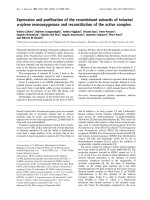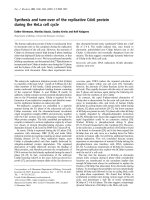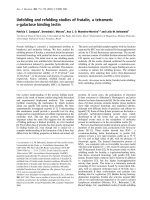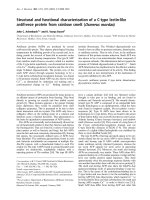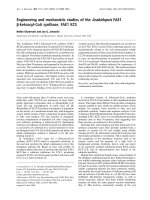Báo cáo y học: "Demographic and clinical predictors of depressive symptoms among incarcerated women" potx
Bạn đang xem bản rút gọn của tài liệu. Xem và tải ngay bản đầy đủ của tài liệu tại đây (234.09 KB, 7 trang )
PRIMARY RESEARCH Open Access
Demographic and clinical predictors of
depressive symptoms among incarcerated
women
Carmen SV Pinese, Antonia RF Furegato
*
, Jair LF Santos
Abstract
Background: Imprisonment may lead to the development of mental illness, especially depression. This study
examines the clinical and sociodemographic profiles of imprisoned women, identifies indicative signs of
depression, and relates these indicators to other variables.
Methods: This study took the form of descriptiv e exploratory research with a psychometric evaluation. A total of
100 of 300 women in a female penitentiary were interviewed. A questionnaire with sociodemographic, clinic al and
penal situation information was used, along with the Beck Depression Inventory. The authors performed bivariate
and multivariate analysis regarding depression.
Results: In all, 82 women presented signs of depression (light = 33, mild = 29 and severe = 20). Comorbidities,
lack of religious practice, absence of visitors and presence of eating disorders were risk factors for depression
(P = 0.03, 0.03, 0.02, 0.04, and 0.01). Being older was a protection factor against severe depression; for women over
30, the risk of depression was multiplied by 0.12. The rate of depression among women prisoners was high.
Conclusions: Comorbidities, the lack of religious practice, not having visitors and eating disorders are significant
risk factors for depression, while age is a protective factor, among incarcerated women.
Introduction
The prison population, especially the female sector,
grows every day. Data from the Brazilian National Peni-
tentiary Department shows that in 2005 the prison sys-
tempopulationintheStateofSãoPaulowas120,601
with 3,903 women, and in 2008, it was 145,096 with
6,520 women. Among the reasons that result in women
being sent to prison is involvement with drug users/traf-
fickers [1,2].
Epidemiological studies have shown gender differences
in the occurrence, prevalence and course of mental
behavior issues and disorders. Women present excep-
tional vulnerability to symptoms of depression and anxi-
ety, mainly associated with their reproductive period [3].
The prevalence ratio for women has varied from 1.5
to 3.0, reaching an average female to male ratio of
2:1 [4-7].
The prison environment neutralizes the formation and
development of basic human values, contributing to
stigmatization, altering the convict’s conduct and leading
to temporary or even irreversible psychic sequelae [8,9].
Mental disorders occur frequently in the context of
reclusion. Although evidence suggests that imprison-
ment conditions can lead to anxiety, depression, self-
harming or heteroaggressive behavior, obsessio ns,
psychoactive substance abuse and suicide, there is no
agreement in the literature on the causal relationship
between confinement and mental disorders [8,10-12].
In addition to feelings of inadequacy, important feel-
ings in imprisoned people are anticipated suffering in
life outside of incarceration, fear of family abandonment,
guilt for being absent from raising and educating their
children, losing their right t o the social importance of
work, identity loss, social discrimination that impairs
prospects for working outside of the criminal context,
and social recognition [12-14]. This study was carried
out due to the high frequency of depression among
women inmates with the belief that these women need
* Correspondence:
Department of Psychiatric Nursing and Human Sciences, College of Nursing,
University of São Paulo at Ribeirão Preto, Ribeirão Preto, Brazil
Pinese et al . Annals of General Psychiatry 2010, 9:34
/>© 2010 Pinese et al; licensee BioMed Central Ltd. This is an Open Access article distributed under the terms of the Creative Commons
Attribution License (http://creativecommons .org/licenses/by/2.0), which permits unrestricted use, distribution, and reproduction in
any medium, provided the original work is properly cited.
improved conditio ns to be able to serve their t ime with
dignity.
This study identifies the clinical, sociodemographic
and penal profile of women in a prison unit of the State
of São Paulo, and evaluates possible associations of
these variables to indicators of depression.
Methods
This is an analytic descriptive study using psychometric
evaluation. The research was carried out in the Health
Clinic of a female penitentiary in Ribeir ão Preto, Brazil.
The institution has a holding capacity of 310 women.
Thoseunderadisciplinaryregimewereexcluded
(around 10 women). A disciplinary regime involves
women that have broken the rules of the institution and
have been removed from the main prison population for
a period of time, depending on the severity of the
infraction, and according to what is proscribed in the
Law for Penal Execution.
Among the 300 inmates, 100 took part in the study
(33% of the viable population). At first, the selection cri-
terion for the sample would be to choose the 100
women that had ju st come into the Prison Unit. After a
pilot test, the identification in strument was adapted.
The authors decided to randomly select participants by
drafting 100 inmates, regardless of the time spent in the
prison unit. In this way, the same inclusion probabilities
were given to all inmates.
Clinical, sociodemographic and penal questionnaire
Thequestionnaireusedisadescriptiveinstrument
comprised of questions pertaining to identification
and sociodemograph ic data, including clinical informa-
tion and penal situation. The subject’s identific ation
starts with a code (no names were u sed), with infor-
mation regarding confinement start date in the insti-
tution, age, ethnicity, marital status (married, non-
married), education level, profession, work, origin,
place of living, family income, religion, and included a
visitors log. Clinical information was evaluated for the
presence of diseases or illnesses, disabilities, limita-
tions, medication use, number of children and abor-
tions, weight, alteration of eating habits, physical
status, sexual activity, and smoking habits. The penal
situation survey topics were the article of the penal
code violated, time sentenced and served and recon-
viction, if any.
The Beck Depression Inventory was used to assess
depression. It evaluates the presence of depressive symp-
toms, with 21 items, using 4 levels of intensity. The
Beck Depression Inventory [15] has been translated and
validated in Portuguese [16,17], with a Cronbach a of
0.81 and mean score of 8.5 ± 7.0, similar to several
other studies.
Data were collected between May and September
2007. Subjects were interviewed individually, and the
researcher filled out the answer forms at the time in
order to minimize loss of information.
The project was approved by the Ethics on Research
Committee of the EERP-USP (Proc. 0687), and by the
directors of the Female Penitentiary of Ribeirão Preto.
After e xplaining the goal of the interview, participation
and use of results to the participants of this study, they
signed free and informed consent forms. Two inmates
did not agree to participate in the study, and so two
additional inmates were selected from the population.
Cases identified as positive for depression were for-
warded to professionals involved in medical and nursing
care within the institution. The most severe cases were
forwarded to specialized psychiatric care.
After statistical and descriptive data analysis, depres-
sion was related to the other variables through multi-
variate and bivaria te analysis. The independent variables
used wer e: age, ethnicity, living together with a p artner,
education level, comorbidities, religion, eating habits,
visitors, sleep, and tobacco use. All were treated as bino-
mials with values of 0 and 1.
Dependent variable depression was classified into four
levels: no depression, light, mild and severe depression,
using the Beck scale. Due to the high occurrence of peo-
ple with symptoms suggesting severe depression, includ-
ing those presenting suicide risks, cut-off values for the
suspected population were adopted and defined as:
absence of depression (0-9), light depression/dysthymia
(10-18), mild depression (19-29), severe depression (30
or more), as suggested by Beck et al. [18].
The multinomial logistic regression model was
adopted with the outcome variables having the classes 0,
1, 2 or 3 in order to perform a compoun d appreciation
of the possible influences of the independent variables
on depression. The relative risk ratio was chosen as the
comparison element [19]. Factors associated with each
category of depression were compared to the base cate-
gory (no depression) and P values smaller than 0.05
were considered significant. The discussion of the
results is supported by t heoretical references from the
literature on the theme.
Results
Clinical, sociodemographic and penal profile
Subject identification
The 100 women interviewed ranged in age from 20 to
63, most of whom were between 20 and 29 (52%), Cau-
casian (65%), and single (70%); 45% noted having part-
ners (Table 1).
Only three were illiterate, 77% had elementary educa-
tion or had not completed high school, 20% had com-
pleted high sc hool and two had college degrees. Most of
Pinese et al . Annals of General Psychiatry 2010, 9:34
/>Page 2 of 7
them had worked before being incarcerated (62%).
Family monthly income varied from up to minimum
wage (29%), between one and two times minimum wage
(26%), between two and three times minimum wage
(14%), and above three times minimum wage (31%). The
Brazilian minimum wage is about US $250/month.
For housing, 61% owned their own houses, 26% rented
and 13% borrowed. Eight of them lived alone and 82%
ranged from two to seven people living in the same
house.
For religion, 45% were Catholics, 37% were part of the
Evangelical church, and 57% of this total practiced their
religion.
In all, 4 wo men were from the city of Ribeirão Preto
and 5 were from the region; 80 women were from other
regions of the state, 10 from other states, and 1 from
another country.
Clinical information
According to the self-evaluation of the studied women,
almost 50% had no diseases; 25% had cardiorespiratory
diseases and hypertension, 6% had psychiatric disorders
and 19% had other diseases. The majority did not pre-
sent any kind of disability. Many women responded that
their major limitation was being in prison. Authors also
found eating and sleeping disorders, and a lack of physi-
cal and sexual activity; 60% of the women smoked
(Table 2).
The tests indicated a significant prevalence of depres-
sion among women in prison, although they do not
recognize it i n their self- evaluation. The cases identified
were managed and referred for specialized treatment.
Penal situation
ThemostfrequentlyviolatedBrazilianpenalcode
among the inmates was penal code 12: Illicit drugs traf-
ficking (64%). Conviction time varied from no current
conviction (that is, awaiting trial = 11) to 3 years (18).
Most of them had already completed 2 years of their
sentence (58%) or 2 to 4 years (32%).
Depression and the variables
The results demonstrated that among the 100 women
interviewed, 82 presented indicative signs of depression,
and 20 of them were considered severe. Objective data
and the relationship with depression are shown in Table 3,
highlighting the higher frequencies of light, mild and
severe depression. Complementary data, mainly subjective
data, are presented below.
Of the eight women living alone, only one of them
showed no signs of depression. The most severe cases of
depression were among Catholics and women from the
Evangelical church. Of the 2 0 severe depression cases, 3
had had 1 abortion and 1 had had more than 5 abortions.
Eating habit alterations showed significant results
regarding depression. All 18 women with no signs of
depression reported that they did not have sleeping pat-
tern alterations. As for the 20 severe cases of depression,
9 reported that they did not have sleeping pattern
alterations.
Table 1 Inmate distribution in a female penitentiary
according to their sociodemographic features (n = 100)
Sociodemographic feature Value
Age 20-30 52
30-40 28
40+ 20
Ethnicity Caucasian 65
Black 35
Origin City of Ribeirão Preto 4
Region 5
Other regions of the state 80
Other state 10
Other country 1
Marital status Single 70
Married 15
Separated 11
Widowed 4
Education Illiterate 3
Incomplete fundamental education 49
Complete fundamental education 7
Incomplete high school 21
Complete high school 14
Incomplete university degree 4
University degree 2
Table 2 Clinical information on 100 imprisoned women
Clinical information %
Diseases No diseases 45
Cardiorespiratory 30
Other 19
Psychiatric 06
Disabilities None 92
Obstetrics No. of children:
None 21
1-3 60
≥419
Abortion 29
Active sexually 10
Eating habit alterations Yes 32
Sleeping habit alterations Yes 68
Practice physical activity Yes 23
Smoking No. of cigarettes/day:
None 42
Less than 19 24
More than 20 34
Pinese et al . Annals of General Psychiatry 2010, 9:34
/>Page 3 of 7
Although the prison offered physical activity pro-
grams, 77% of women did not take part in them. Even
when showing no depression, most women did not
practice physical activity. Among the 18 women that
showed no sig ns of depression were all the women who
had worked before imprisonment.
Of the 89 convicted women, 72 showed signs of
depression. As f or reconviction, 81 women were first-
time offenders. Of the 20 wo men showing signs of
severe depression, 5 were reconvicted. In one case this
was for the seventh time.
In the multivariate analysis, age, comorbidities, reli-
gion, eating habit alterations and receiving visitors wer e
significant variables (Table 4). The presence of comor-
bidities multiplied the risk for l ight depression by a fac-
tor of 5.43 and for severe depression by 8.81. Not
practicing rel igion increased the probability of present-
ing mild depression (6.09). Eating habit disorders were
Table 3 Independent variable frequencies by levels of depression and P value of Mann-Whitney test
Variables P value Category N Depression levels
No depression Light Mild Severe
N % N% N% N%
Age 0.206 Under 29 52 08 15.4 15 29 19 36.5 10 19.1
≥30 48 10 20.8 18 37.6 10 20.8 10 20.8
Ethnicity 0.704 Caucasian 65 13 20 19 29.3 18 27.7 15 23
Non-Caucasian 35 5 14.3 14 40 11 31.4 5 14.3
Educational level 0.492 Up to complete fundamental education 59 10 17 20 34 14 23.7 15 25.3
Above 41 8 19.5 13 31.7 15 36.6 5 12.2
Eating Habits 0.000 No alterations 47 13 27.7 20 42.5 10 21.3 4 8.5
Alterations 53 5 9.4 13 24.5 19 35.9 16 30.2
Sleep 0.000 No alterations 68 18 26.5 22 32.4 19 27.9 9 13.2
Alterations 32 11 34.4 10 31.2 11 34.4
Tobacco 0.290 No 42 5 12 21 50 12 28.5 04 9.5
Yes 58 13 22.4 12 20.7 17 29.3 16 27.6
Comorbidities 0.155 No 45 11 24.5 14 31.1 15 33.3 5 11.1
Yes 55 7 12.7 19 34.5 14 25.5 15 27.3
Religion 0.810 Practicing 57 12 21 20 35 12 21 13 23
Not practicing 42 6 24.3 13 32 16 38 7 16.7
Marital status 0.358 Married 45 8 17.8 11 24.5 18 40 8 17.7
No married 55 10 18.2 22 40 11 20 12 21.8
Visitors 0.322 Yes 49 11 22.5 14 28.6 18 36.7 6 12.2
No 51 7 13.7 19 37.3 11 21.6 14 27.4
Total 100 18 33 29 20
Table 4 Multinomial logistic regression for the outcome variable ‘depression’ among inmates
Independent
variables
Outcome variable
Light depression Mild depression Severe depression
Relative risk
ratio
P
value
Standard
error
Relative risk
ratio
P
value
Standard
error
Relative risk
ratio
P
value
Standard
error
Age 0.47 0.34 0.37 0.23 0.08 0.19 0.12 0.04 0.12
Ethnicity 2.00 0.39 1.60 1.21 0.82 1.00 0.51 0.502 0.51
Marital status 1.27 0.76 0.97 0.39 0.24 0.31 1.89 0.504 1.81
Education 0.51 0.37 0.38 0.93 0.93 0.73 0.17 0.09 0.17
Comorbidities 5.43 0.04 4.38 3.17 0.17 2.66 8.81 0.03 8.80
Religion 2.76 0.21 2.25 6.09 0.03 0.60 5.78 0.08 5.80
Eating habits 1.46 0.63 1.16 5.70 0.04 4.71 11.11 0.01 10.93
Visitors 2.57 0.21 1.92 2.23 0.32 1.78 9.15 0.02 8.66
Tobacco 0.22 0.06 0.17 0.70 0.68 0.60 2.13 0.453 2.15
Wald statistics = w = 77.7 P < 0.000 Pseudo RZ = 0.289. Bold types for p values indicate significance at the level of 0.05.
Pinese et al . Annals of General Psychiatry 2010, 9:34
/>Page 4 of 7
strongly associa ted with mild depression (5.7) and with
severe depression (11.11). A strong association between
not receiving visitors and showing severe depression was
shown (9.15). The variable sleep was excluded from the
regression analysis because of instability: t he contrast
category (yes) has a null frequency scale.
Being older was a protecting factor for severe depres-
sion. In other words, women over 30 present the risk of
being in this category multiplied by a factor of 0.12.
Discussion
In typical mild, moderate, or severe depressive episodes,
the patient suffers from a lowering of mood, reduction
of energy, and decrease in activity. Capacity for enjoy-
ment, interest, and concentra tion are reduced, and
marked tiredness after even minimum effort is common.
Sleep is usually disturbed and appetite diminish ed. Self-
esteem and self-confidence are almost always reduced
and, even in the mild form, some ideas of guilt or
worthlessness are often present. The lowered mood var-
ies little from day to day, is unresponsive to circum-
stances and may b e accompanied by so-called ‘somatic’
symptoms, such as loss of interest and pleasurable feel-
ings, waking in the morning several hours before the
usual time, depression worsening in the morning,
marked psychomotor retardation, agitation, loss of appe-
tite, weight l oss, and loss of libido [20]. The subsyndro-
mic expressions of depressive disorders are more
difficult to study, but also have a significant negative
impact on patients’ quality of life [6,15,21].
Data on the presence of depression amo ng convicted
women in this study are reason for concern. They are
above the general population indexes [4,6,7,14]. Data in
the literature diverge: in one report, between one-third
and one-half of the British female penitentiary popula-
tion presented some type of mental disorder [10]. In
Chicago, mental disorder rates in the imprisoned popu-
lation wer e three to four times higher than the general
population; these rates were even higher when only
women were considered [11]. Further, a B razilian study
demonstrated a low prevalence of psychiatric cases
among the female prison population [12].
In the 40 years old or above age group, this study
demonstrated a higher percentage of women showing
no signs of depression. The multivariate analysis showed
that being in the age group 30 years old or more is a
protective factor for depression. This finding contrasts
with what is known about the association between old
age and depression, but it must be noted that 30 years
is a very low cut off for age.
Although 70 inmates were single, 45 reported having a
companion. A fact to note is that of the 20 women with
severe depression, 16 were singl e. In contrast, mild
depression was more frequent among those that
reported having a partner. Being married is associated
with a lower rate of depression in men; however, being
single is a condition associated with a lower rate of
depression in women, as found in gender specific stu-
dies [21,22].
Both in this study and in a study carried out in a
female penitentiary in Rio de Janeiro, there was no
direct relationship between low educ ation and socioeco-
nomic condition with criminal rates [23] and depression.
Neither having a job previous to imprisonment nor
working as an option in the institution showed signifi-
cant differences regarding depression. Most of the
inmates did not take part in any type of activity, particu-
larly those with severe depression. Being depressed acts
as an inhibiting factor of the will, initiative for practicing
physical activities and other efforts. In contrast, working
and e xercise could stimulate positive attitudes in these
women [13].
A total of 12 women reported not having any religion
and, within this group, no case of severe depression was
found. However, when the variable was submitted to
multivariate analysis for mild depression, it demon-
strated a strong relationship between having a religion
and developing mild depression. Another study has
demonstrated that religion can ease the routine and bur-
den of convicted women in prison [12].
Depression is an illness that frequently accompanies
comorbidities, especially chronic diseases and alcohol
and drug use. Prevalence rates for d epressive disorders
among somatic disease patients are substantial, from 22
to 33%. This is frequently a sourc e of difficulty in the
diagnoses of depression in primary health services [6,24].
Among the inmates surveyed in this study, of the 23
that presented cardiac and respiratory diseases, 22
showed signs of depression. The most common general
comorbidities were high blood pressure, ischemic dis-
eases, hypothyroidism, o ther thyroid disorders, and dia-
betes. The fact that comorbidities were highly significant
for light an d severe depression stands out as confirming
the data in the literature [25,26].
Many inmates affirm not having any diseases, disabil-
ities or limitations. However, among eight people that
reported some type of disability (five with visual disabil-
ities, one with a mobility d isability and dwarfism) all
hadsomedegreeofdepression,exceptonethatpre-
sented stroke sequelae with no signs of depression.
Regarding limitations, apart from being imprisoned
(with no right to leave), most w omen feel they have no
limitations. Although rates of women with disabilities
and limitations were the same, they did not overlap.
Some women that objectively had disabilities subjec-
tively did not feel they had any limitations.
Eating habit alterations showed significant results in
the multivariate analysis of this study regarding
Pinese et al . Annals of General Psychiatry 2010, 9:34
/>Page 5 of 7
depression. Of all 82 cases showing depression, 53
reported eating habit alterations, confirming the data in
the literature on this subject [24]. Sleeping h abit altera-
tions were also noted. Many women reported that they
wake up during their sleep. Depression is cha racterized
by frequently disturbed sleep, usually by terminal insom-
nia. Decrease in appetite is also present, generally fol-
lowed by a slight weight loss [27,28].
Regarding the obstetrical aspects surveyed in this
study, of the 60 women that had 1-3 children, 50
showed some degree of depression, and among these 13
showed severe depression. A study carried out on
women aged between 45 and 55 years old in Poland
found more pregnancies, more abortions, pregnancy
complications, and post-labor depression in women with
higher levels of depression. A study carried out in a
female police station in Belo Horizonte pointed to a
relationship between starting a criminal life and ma ter-
nity. Women justify crimes by trying to ensure comfort
and the acquisition of consumer goods for their children
[29].
Receiving visitors was a relevant factor for women
with severe depression. When they are incarcerated,
women are also forced into separation from their chil-
dren and family , causing grief, distress, loneliness, long-
ing, loss, and regret. In addition, intimate visits are
difficult [1]. However, family, religious and professional
links can act as positive supports to depressive persons.
Of the 100 women interviewed, many s moked more
than 20 cigarettes a day and 11 showed signs of severe
depression. Despite these indicators, the multivariate
analysis did not find any direct relationship between
smoking and depression. The literature affirms that
being a smoker can increase the frequency of a
depressed state [6,14,24].
The major criminal offenses were drug trafficking
(64%) and robbery (12%); 81% were in prison for the first
time, 89% had already being convicted and 59% of them
had been in prison for at least 2 years [2]. When analyzed
by nursing staff in the context of a female prison, the
nursedoesnotseethecrimecommittedbytheinmate,
but only the consequences to her rehabilitation [30].
It is important to point out that in spite of the fact
that some variables are totally independent from the
outcome variable (depressive symptom), the resu lts con-
firm their connection to the depressive clinical status.
This study did not aim to investigate the ‘pos sible’ use
of illicit drugs in the prison system. Ho wever, the high
rate of conviction for drug trafficking among the prison-
ers as well as the high frequency of depressive symp-
toms shows the need for further studies on this.
As this prison unit does not have specialized psychia-
tric care, the clinical diagnosis of depression was not
carried out alongside the investigation. Suspect cases
were forwarded for care and follow-up.
Conclusions
Multivariate analysis has indicated the risk factors that
contribute to the manifestation of depression (comor-
bidities, religion, eating habits and visit ors), and that age
can be a protective factor, for imprisoned women.
These results may provide information for planning
special nursing care, and also the manage ment of ser-
vices and policies aimed at this population.
Study limitations
The experience o f carrying out this data collection i n
the field was enriching and, at the same time, wearying.
The theme of the research is profound, causing deep
emotional responses in the inmates interviewed. The
nurse spent the necessary time to listen to the inmates
fully, a fact that consequently reduced the number of
data collections possible per day.
Acknowledgements
Part of this study were supported by. Process 305698/06-0
Authors’ contributions
CSVP and ARFF conceived this study, and participated in its design and
coordination. CSVP did the data collection. JLFS participated in the design of
the study and performed the statistical analysis. All authors read and
approved the final manuscript.
Competing interests
The authors declare that they have no competing interests.
Received: 5 February 2010 Accepted: 6 September 2010
Published: 6 September 2010
References
1. Giordani AT, Bueno SMV: The maternity to imprisoned women and the
transmission of DST/Aids. DST- J Bras Doenças Sex Transm 2001, 13:12-24.
2. Brasil, Departamento Penitenciário Nacional: Sistema Penitenciário no Brasil.
Dados consolidados Brasília: Ministério da Justiça 2006.
3. Lopez AD, Murray CJC: The global burden of disease, 1990-2020. Nat Med
1998, 94:1241-1243.
4. Weissman MM, Bland RC, Canino GJ, Faravelli C, Greenwald S, Hwu HG,
Joyce PR, Karam EG, Lee CK, Lellouch J, Lépine JP, Newman SC, Rubio-
Stipec M, Wells JE, Wickramaratne PJ, Wittchen H, Yeh EK: Cross-national
epidemiology of major depression and bipolar disorder. JAMA 1996,
276:293-299.
5. Parry B, Newton RP: Chronobiological basics of female-specific mood
disorders. Neuropsychopharm 2001, 25:102-108.
6. Maj M, Sartorius N: Depressive disorders Porto Alegre, Brazil: Artmed 2005.
7. Angst J, Gamma A, Gastpar M, Lépine JP, Mendlwiccz J, Tylle A: Gender
differences in depression epidemiological findings from the European
Depress I and II studies. Europ Arch Psych Clin Neurosci 2006, 252:201-209.
8. Muakad IB: Prisão albergue São Paulo, Brazil: Atlas, 3 1998.
9. Brasil, Ministério da Justiça, Central Nacional de Apoio e Acompanhamento
às Penas alternatives: Manual de monitoramento das penas e medidas
alternativas Brasília: Ministerio da Justiça 2002.
10. Jordan BK, Schlenger WE, Fairbank JA, Caddell JM: Prevalence of
psychiatric disorders among incarcerated women. Arch Gen Psych 1996,
53:513-519.
Pinese et al . Annals of General Psychiatry 2010, 9:34
/>Page 6 of 7
11. Teplin LA, Abram KM, Mcclelland GM: Prevalence of psychiatric disorders
among incarcerated women: I. pretrial jail detainees. Arch Gen Psych
1996, 53:505-512.
12. Moraes PAC, Dalgalarrondo P: Women imprisoned in São Paulo: mental
health and religiosity. J Bras Psiq 2006, 55:50-56.
13. Fernandes R, Hirdes A: Convicts’ perception of prison an of privation of
liberty. Rev Enf UERJ 2006, 14:418-424.
14. Sadock BJ, Sadock VA: Compêndio de Psiquiatria Porto Alegre, Brazil: Artmed
2007.
15. Beck AT, Ward CH, Mendelson M, Mock J, Erbaugh J: An inventory for
measuring depression. Arch Gen Psych 1961, 4:561-571.
16. Gorenstein C, Andrade L: Validation of a Portuguese version of the Beck
Depression Inventory and the State-trait Anxiety Inventory in Brazilian
subjects. Braz J Med Biol Res 1996, 29:453-457.
17. Gorenstein C, Andrade L: Beck Depression Inventory: psychometric
properties of the Portuguese version. Rev Psiq Clin 1998, 25:245-250.
18. Beck AT, Steer RA, Garbin MG: Psychometric properties of the Beck
Depression Inventory: twenty-five years of evaluation. Clin Psychol Rev
1998, 8:77-100.
19. Hamilton LC: Statistics with Stata Belmont, CA: Thomson Learning 2004.
20. World Health Organization: International Statistical Classification of
Diseases and Related Health Problems, 10th Revision. Geneva,
Switzerland: World Health Organization 1992.
21. Almeida-Filho N, Lessa I, Magalhães L, Araújo MJ, Aquino E, James SA,
Kawachi I: Social inequality and depressive disorders in Bahia, Brazil:
interactions of gender, ethnicity and social class. Soc Sci Med 2004,
59:1339-1353.
22. Hernandez P, Alonso S, (Eds): Women and depression New York, NY: Nova
Science 2009.
23. Soares BM, Ilgenfritz I: Prisioneiras: vida e violência atrás das grades Rio de
Janeiro, Brazil: Garamond 2002.
24. Roca M, Giner D: Depresión, sintomas físicos y somatización. Actas Españ
Psiq 1996, 3:43-56.
25. Denerstein L, Lehert P, Burger H, Dudley E: Mood and the menopausal
transition. J Nerv Ment Dis 1999, 187:685-691.
26. Wojnar M, Dród W, Araszkiewicz A, Szymański W, Nawacka-Pawlaczyk D,
Urbański R, Hegedus AM: Assessment and prevalence of depression in
women 45-55 years of age visiting gynecological clinics in Poland:
screening for depression among midlife gynecologic patients. Arch
Womens Ment Health 2003, 6:193-201.
27. Brasil, Ministério de Saúde do Brasil, Organização Pan-Americana de Saúde
no Brasil: Doenças relacionadas ao trabalho: manual de procedimentos para
os serviços de saúde Brasilia: Ministério da Saúde do Brasil 2001, série A:114.
28. American Medical Association: Essential guide for depression São Paulo,
Brazil: Aquariana 2002.
29. Guedes MA: Psychosocial intervention in the female prison system. Psicol:
Cien Prof 2006, 26:558-569.
30. Pinese CSV: Análise do contexto funcional de uma penitenciária feminina com
enfoque nas ações de enfermagem Ribeirão Preto, Brazil: EERP/USP 2005.
doi:10.1186/1744-859X-9-34
Cite this article as: Pinese et al.: Demographic and clinical predictors of
depressive symptoms among incarcerated women. Annals of General
Psychiatry 2010 9:34.
Submit your next manuscript to BioMed Central
and take full advantage of:
• Convenient online submission
• Thorough peer review
• No space constraints or color figure charges
• Immediate publication on acceptance
• Inclusion in PubMed, CAS, Scopus and Google Scholar
• Research which is freely available for redistribution
Submit your manuscript at
www.biomedcentral.com/submit
Pinese et al . Annals of General Psychiatry 2010, 9:34
/>Page 7 of 7




